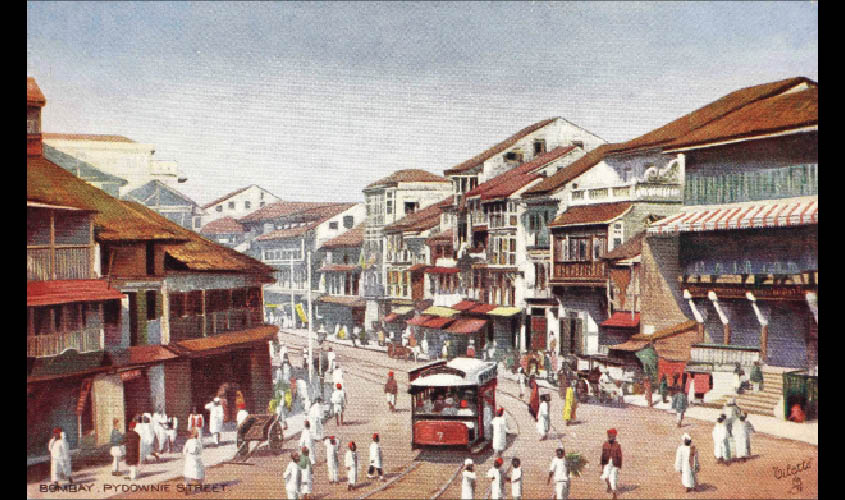Globetrotters: Early Postcards from the Indian Subcontinent, now on view at Delhi’s Triveni Kala Sangam, presents a pictorial history of the pre-Independence postcard. More than 350 picture postcards, dating from 1890 to 1947, are exhibited here, writes Bhumika Popli.
Before we arrived at WhatsApp forwards and Facebook messages, postcards were among our chief modes of long-distance communication. Sized roughly at six-by-four inches, these cream-coloured, thick sheets of paper, were sent across the world by people from all walks of life. The postcards most of us remember are the plain, monochromatic kind. The ones we have forgotten are the more vivid variants of travel postcards that carried printed images of iconic sites and symbols.
A new exhibition at Art Heritage Gallery I and II, located on the premises of Delhi’s Triveni Kala Sangam, entitled Globetrotters: Early Postcards from the Indian Subcontinent, brings us face to face with a series of picture postcards printed in pre-Independence India.
More than 350 postcards, dating from 1890 to 1947, are displayed at the show. At the exhibition venue, a video is also played for visitors, taking them on a nostalgic trip to India’s colonial cities and hill stations, which were often depicted on the postcards of that era.
Viewers will also see renditions of artworks printed on some of these postcards, by acclaimed Indian painters Raja Ravi Varma and M.V. Dhurandhar. Many of the postcards featured here carry images from Indian history, events like the uprising of 1857 and the third Coronation of Delhi in 1911.

The exhibition is an extension of a newly launched book, entitled Paper Jewels: Postcards from The Raj, written by Omar Khan, a California-based historian and a keen researcher of the early photography scene of the Indian subcontinent. The book includes around 500 illustrations and a number of essays on the subject.
According to Khan, “The history of the picture postcard in India is closely intertwined with Germany and Austria, countries where most image postcards were first printed. The very nature of postcards was global: a photograph would be sent to Dresden by a publisher from India, postcards would be struck from it by a printer there and then shipped back to Jaipur to be sold to tourists outside the Hawa Mahal or other tourist spots and finally it would be mailed to London, arriving there two weeks later.”
Certain exhibitions come across as lessons in art history. Globetrotters is one of those. It showcases the fascinating history of the Indian subcontinent through postcards which are rendered in diverse formats. Postcards displayed here are labelled as lithographs, collotypes, halftones, along with real picture postcards.
A few of the images from the postcards are also blown-up and used as backdrops to the framed exhibit. These images appear pixellated but draw the viewer in due to their appealing nature.
The show is divided into various segments. We see postcard renditions of paintings— Shakuntala Patra Lekha (Shakuntla Writing a Letter) and Mohini—by Ravi Varma. Some postcards feature cityscapes of Delhi, Bombay, Kolkata and Chennai. Another one shows a huge mass of people at the Delhi Durbar in 1911, when Queen Victoria was declared as the Empress of India. Also on display are the portraits of natives and multiple views of city life from that period.

According to Raahab Allana, co-curator of the show, we are presented here with a history of the postcard on the Indian subcontinent. He says, “Yes, there are only a few devoted initiatives for postcard history in India or Southeast Asia. There has been another book, titled India by Design: Colonial History and Cultural Display, published in 2007, by Saloni Mathur, in which she has written an essay on postcard history. Other than that you don’t really have a lot. Sometimes we find a reference in a book so on and so forth on postcard history. I would say that this till date has been the most comprehensive study of the postcard, certainly. Which is why we were so interested because literally, it is the first of its kind. This show has been previously shown at Bombay.”
Not every exhibit displays a happy scene, though. Postcards from Pakistan and the Northwest Frontier territories in the exhibition show disturbing, violent images. I ask Allana about the printing of these postcards. We are used to seeing happy, picturesque images on postcards, so how and what led to the printing of these?
He says, “The moral-ethical barometer of what people were in the early 20th century is vastly different from what we are showing. And there is no reason to believe that postcards because of their dissemination capacity were also sort of treading the line of journalism and showing the ground realities. We have also shown images of famine and plague and by sharing those with NGOs we raise funds for these issues. The image became important for spreading awareness to the world. And often the awareness has to do with harsh ground realities and in a way, I am very happy that those ground realities were disseminating at that time when the contours of censorship were so vast. By 1910, there were about 800 million postcards in the world and hence we can’t underestimate their capacity for change.”
The exhibition is organised by Art Heritage and Alkazi Foundation for the Arts, and is on view at Delhi’s Triveni Kala Sangam till 17 November; ‘Paper Jewels: Postcards from the Raj’ is published by Alkazi Collection of Photography and Mapin Publishing

